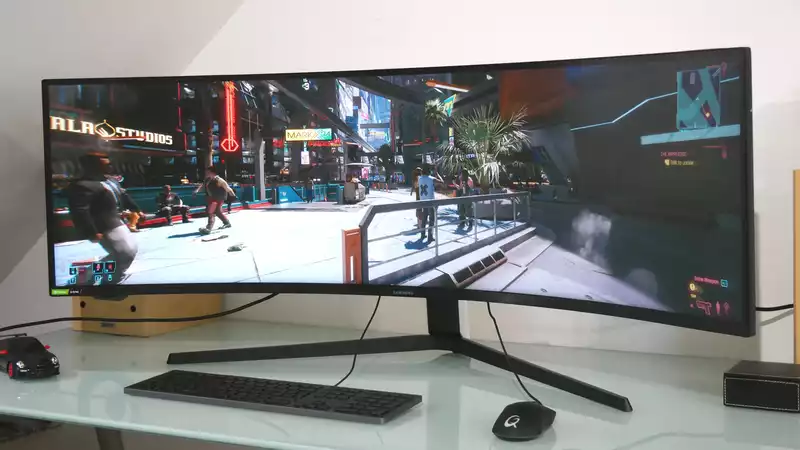Unlike many PC components, monitor technology has progressed gradually. But not now. Just a few years ago, it would have been difficult to imagine a monster like the Samsung Odyssey G9 at 49 inches with a ridiculous curve of 1000R. In a few years it will be completely outdated.
I will explain why in a moment. But before we do, let's get the reasons why the Samsung Odyssey G9 is such an eye-opening product here and now. Of course, it all starts with that ridiculous 49-inch panel, whose native resolution of 5,120 x 1,440 is not all that exciting, given its size and aspect ratio. Indeed, pixel density is not impressive at 109 pixels per inch. This is not a high-DPI experience.
Instead, what sets the G9 apart from all other monitors is the sheer scale and ridiculously tight curvature: the 1000R curve means that if the panel were extended to complete the circle it is partially drawing, the radius of that circle would be only one meter. Ridiculous.
Other key features of this panel include 240Hz refresh, FreeSync and G-Sync support, HDR 1000 certification including 1,000 nits peak brightness, 2,500:1 contrast, 95% coverage of the DCI-P3 color gamut, and 1ms response. It's a heck of a list. Then there are the panel types. Samsung used VA technology, which is usually excellent for contrast but poor for responsiveness.
In any case, the G9 is worth a million dollars from any angle. The casing is plastic. But the glossy white finish looks classy, and the "Infinity Core" LED lighting is clever and funky. The overall effect is that of a big-budget sci-fi prop. We like it.
We also like most aspects of the Odyssey G9's performance. Very much. First, let's address our doubts about the VA panel's response. Samsung has included three user-configurable overdrive levels in the G9's OSD menu. Subjectively, these are difficult to discern. But the key conclusion is that the G9 is appropriately fast and comparable to a 1ms IPS monitor. Phew.
There is a slight drawback. Overdrive is not available in adaptive refresh mode or in low input lag mode. However, even with FreeSync or G-Sync available, the response is good and there is no visible lag, with or without low input lag mode enabled.
The big issue is HDR performance. This is a bit of a mess. For starters, the G9 has local dimming as one would expect from an HDR1000 panel, but it is limited to just 10 edge-lit zones, making it completely useless. In reality, however, HDR content is underwhelming on the G9 and lacks the visual height one would normally expect from an HDR1000 panel.
Therefore, the monitor works best as a particularly punchy SDR screen, delivering 420 nits in this mode; in PC gaming terms, until you see CyberPunk 2077 in all its ray-traced, DLSS-enhanced glory on the G9, you You haven't lived. It's very special. Much of that is due to the immersive experience, and the astounding aspect ratio of 32:9, coupled with the extremely tight curves and massive 49-inch proportions, make for an incredibly enveloping experience. Just keep in mind that you'll need a heck of a graphics card to make this screen run smoothly with the latest games. The overall pixel count is roughly equivalent to full 4K.
Of course, extreme aspect is not a winner for all game types; for online shooters, including battle royale-type games like "Call of Duty: Warzone" and "Fortnite," the wide field of view available inevitably seen as an unfair advantage. Therefore, they must choose between stretching a 16:9 field of view into a 32:9 panel or displaying huge black bars on the left and right sides.
More generally, the ultra-wide aspect may or may not fit any game UI. Similarly, sharing a monitor with a game console is not a good idea. Also, from a productivity standpoint, the mediocre pixel pitch and shallow panel height limit the G9's appeal. At this price point, there are far better options to get the job done.
Oh, and the obsolescence we mentioned" Samsung is already planning a follow-up to the G9. It will probably have a mini LED backlight with over 2,000 dimming zones. It could be even more expensive. But if you can afford this G9, you can probably afford whatever comes next. In that light, the G9 is impressive in many ways, but its flawed HDR implementation makes this spec feel like a stepping stone, a beta version of what is likely to be an absolutely amazing monitor with an upgrade to mini-LED technology.
It is also worth noting that Samsung offers the CRG90 with similar 49-inch features. In short, the G9 is a great screen. However, it is difficult to recommend it without giving it away.
.

Comments